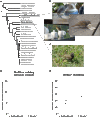Divergence in problem-solving skills is associated with differential expression of glutamate receptors in wild finches
- PMID: 29546239
- PMCID: PMC5851658
- DOI: 10.1126/sciadv.aao6369
Divergence in problem-solving skills is associated with differential expression of glutamate receptors in wild finches
Abstract
Problem solving and innovation are key components of intelligence. We compare wild-caught individuals from two species that are close relatives of Darwin's finches, the innovative Loxigilla barbadensis, and its most closely related species in Barbados, the conservative Tiaris bicolor. We found an all-or-none difference in the problem-solving capacity of the two species. Brain RNA sequencing analyses revealed interspecific differences in genes related to neuronal and synaptic plasticity in the intrapallial neural populations (mesopallium and nidopallium), especially in the nidopallium caudolaterale, a structure functionally analogous to the mammalian prefrontal cortex. At a finer scale, we discovered robust differences in glutamate receptor expression between the species. In particular, the GRIN2B/GRIN2A ratio, known to correlate with synaptic plasticity, was higher in the innovative L. barbadensis. These findings suggest that divergence in avian intelligence is associated with similar neuronal mechanisms to that of mammals, including humans.
Figures




Similar articles
-
Feeding innovations in a nested phylogeny of Neotropical passerines.Philos Trans R Soc Lond B Biol Sci. 2016 Mar 19;371(1690):20150188. doi: 10.1098/rstb.2015.0188. Philos Trans R Soc Lond B Biol Sci. 2016. PMID: 26926278 Free PMC article. Review.
-
On the origin of Darwin's finches.Mol Biol Evol. 2001 Mar;18(3):299-311. doi: 10.1093/oxfordjournals.molbev.a003806. Mol Biol Evol. 2001. PMID: 11230531
-
Evolution of Darwin's finches and their beaks revealed by genome sequencing.Nature. 2015 Feb 19;518(7539):371-5. doi: 10.1038/nature14181. Epub 2015 Feb 11. Nature. 2015. PMID: 25686609
-
Species Limits and Phylogenomic Relationships of Darwin's Finches Remain Unresolved: Potential Consequences of a Volatile Ecological Setting.Syst Biol. 2019 Mar 1;68(2):347-357. doi: 10.1093/sysbio/syy073. Syst Biol. 2019. PMID: 30371872
-
Adaptive radiation of Darwin's finches revisited using whole genome sequencing.Bioessays. 2016 Jan;38(1):14-20. doi: 10.1002/bies.201500079. Epub 2015 Nov 25. Bioessays. 2016. PMID: 26606649 Review.
Cited by
-
Problem Solving in Animals: Proposal for an Ontogenetic Perspective.Animals (Basel). 2021 Mar 18;11(3):866. doi: 10.3390/ani11030866. Animals (Basel). 2021. PMID: 33803609 Free PMC article. Review.
-
What made us "hunter-gatherers of words".Front Neurosci. 2023 Feb 9;17:1080861. doi: 10.3389/fnins.2023.1080861. eCollection 2023. Front Neurosci. 2023. PMID: 36845441 Free PMC article.
-
Interaction of memory systems is controlled by context in both food-storing and non-storing birds.Learn Behav. 2022 Mar;50(1):140-152. doi: 10.3758/s13420-021-00496-z. Epub 2021 Dec 16. Learn Behav. 2022. PMID: 34918201 Free PMC article.
-
Social boldness correlates with brain gene expression in male green anoles.Horm Behav. 2021 Jul;133:105007. doi: 10.1016/j.yhbeh.2021.105007. Epub 2021 Jun 5. Horm Behav. 2021. PMID: 34102460 Free PMC article.
-
How to solve novel problems: the role of associative learning in problem-solving performance in wild great tits Parus major.Anim Cogn. 2024 Apr 12;27(1):32. doi: 10.1007/s10071-024-01872-8. Anim Cogn. 2024. PMID: 38607427 Free PMC article.
References
-
- Timmermans S., Lefebvre L., Boire D., Basu P., Relative size of the hyperstriatum ventrale is the best predictor of feeding innovation rate in birds. Brain Behav. Evol. 56, 196–203 (2000). - PubMed
-
- Mehlhorn J., Hunt G. R., Gray R. D., Rehkämper G., Güntürkün O., Tool-making New Caledonian crows have large associative brain areas. Brain Behav. Evol. 75, 63–70 (2010). - PubMed
-
- Mace G. M., Harvey P. H., Clutton-Brock T. H., Is brain size an ecological variable? Trends Neurosci. 3, 193–196 (1980).
Publication types
MeSH terms
Substances
Grants and funding
LinkOut - more resources
Full Text Sources
Other Literature Sources
Miscellaneous

